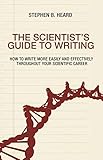The scientist's guide to writing : how to write more easily and effectively throughout your scientific career / Stephen B. Heard.
Material type: TextPublisher: Princeton, New Jersey : Princeton University Press, [2016]Copyright date: ©2016Description: ix, 306 pages : illustrations ; 24 cmContent type: text Media type: unmediated Carrier type: volumeISBN: 0691170215; 9780691170213; 9780691170220; 0691170223Other title: How to write more easily and effectively throughout your scientific careerSubject(s): Technical writing | Technical writing | Wissenschaftliches Arbeiten | Textproduktion | Wissenschaftlicher TextDDC classification: 808/.0665 LOC classification: T11 | .H425 2016T11 | .H43 2016Other classification: 110 | 808.066
TextPublisher: Princeton, New Jersey : Princeton University Press, [2016]Copyright date: ©2016Description: ix, 306 pages : illustrations ; 24 cmContent type: text Media type: unmediated Carrier type: volumeISBN: 0691170215; 9780691170213; 9780691170220; 0691170223Other title: How to write more easily and effectively throughout your scientific careerSubject(s): Technical writing | Technical writing | Wissenschaftliches Arbeiten | Textproduktion | Wissenschaftlicher TextDDC classification: 808/.0665 LOC classification: T11 | .H425 2016T11 | .H43 2016Other classification: 110 | 808.066 | Item type | Current library | Call number | Copy number | Status | Notes | Date due | Barcode |
|---|---|---|---|---|---|---|---|
 Books
Books
|
Female Library | T11 .H425 2016 (Browse shelf (Opens below)) | 1 | Available | STACKS | 51952000225539 | |
 Books
Books
|
Main Library | T11 .H425 2016 (Browse shelf (Opens below)) | 1 | Available | STACKS | 51952000225546 |
Browsing Main Library shelves Close shelf browser

|

|

|

|

|

|

|
||
| T11 .B396 2009 A guide to writing as an engineer / | T11 .F53 2008 Pocket book of technical writing for engineers and scientists / | T11 .G626 2006 Writing for science / | T11 .H425 2016 The scientist's guide to writing : how to write more easily and effectively throughout your scientific career / | T11 .R426 2006 Reporting technical information / | T11 .R426 2009 Reporting technical information / | T11 .S529 2000 Writing for science and engineering : papers, presentations, and reports / |
"The ability to write clearly is critical to any scientific career. The Scientist's Guide to Writing provides practical advice to help scientists become more effective writers so that their ideas have the greatest possible impact. Drawing on his own experience as a scientist, graduate adviser, and editor, Stephen Heard emphasizes that the goal of all scientific writing should be absolute clarity; that good writing takes deliberate practice; and that what many scientists need are not long lists of prescriptive rules but rather direct engagement with their behaviors and attitudes when they write. He combines advice on such topics as how to generate and maintain writing momentum with practical tips on structuring a scientific paper, revising a first draft, handling citations, responding to peer reviews, managing coauthorships, and more. In an accessible, informal tone, The Scientist's Guide to Writing explains essential techniques that students, postdoctoral researchers, and early-career scientists need to write more clearly, efficiently, and easily"--Back cover.
Includes bibliographical references (pages 289-298) and index.
Part I. What Writing Is. 1. On Bacon, Hobbes, and Newton, and the Selfishness of Writing Well ; 2. Genius, Craft, and What This Book Is About -- Part II. Behavior. 3. Reading ; 4. Managing Your Writing Behavior ; 5. Getting Started ; 6. Momentum -- Part III. Content and Structure. 7. Finding and Telling Your Story ; 8. The Canonical Structure of the Scientific Paper ; 9. Front Matter and Abstract ; 10. The Introduction Section ; 11. The Methods Section ; 12. The Results Section ; 13. The Discussion Section ; 14. Back Matter ; 15. Citations ; 16. Deviations from the IMRaD Canon -- Part IV. Style. 17. Paragraphs ; 18. Sentences ; 19. Words ; 20. Brevity -- Part V. Revision. 21. Self-Revision ; 22. Friendly Review ; 23. Formal Review ; 24. Revision and the "Response to Reviews" -- Part VI. Some Loose Threads. 25. The Diversity of Writing Forms ; 26. Managing Coauthorships ; 27. Writing in English for Non-Native Speakers -- Part VII. Final Thoughts. 28. On Whimsy, Jokes, and Beauty: Can Scientific Writing Be Enjoyed?
1 2

There are no comments on this title.